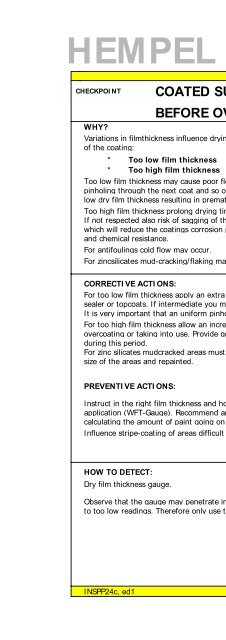Coating Reference Handbook - Hempel
Coating Reference Handbook - Hempel
Coating Reference Handbook - Hempel
Create successful ePaper yourself
Turn your PDF publications into a flip-book with our unique Google optimized e-Paper software.
HEMPEL<br />
CHECKPOINT COATED SURFACE P 24c<br />
BEFORE OVERCOATING<br />
WHY?<br />
Variations in filmthickness influence drying and the protective properties<br />
of the coating:<br />
* Too low film thickness<br />
* Too high film thickness<br />
Too low film thickness may cause poor flow together of the film and result in<br />
pinholing through the next coat and so on. Result will be an open film of<br />
low dry film thickness resulting in premature blistering/pinpoint rusting.<br />
Too high film thickness prolong drying time, and may cause sagging/ running.<br />
If not respected also risk of sagging of the next coat and solvent retention<br />
which will reduce the coatings corrosion protective properties and mechanical<br />
and chemical resistance.<br />
For antifoulings cold flow may occur.<br />
For zincsilicates mud-cracking/flaking may occur.<br />
CORRECTIVE ACTIONS:<br />
For too low film thickness apply an extra coat of same paint, in case of primers,<br />
sealer or topcoats. If intermediate you may be able to catch up in next coat.<br />
It is very important that an uniform pinhole-free paint film is achieved.<br />
For too high film thickness allow an increase in the drying time before<br />
overcoating or taking into use. Provide good ventilation to all surface affected<br />
during this period.<br />
For zinc silicates mudcracked areas must be reblasted or scraped depending on<br />
size of the areas and repainted.<br />
PREVENTIVE ACTIONS:<br />
Instruct in the right film thickness and how to measure continuously during<br />
application (WFT-Gauge). Recommend areas to be subdivided and assist in<br />
calculating the amount of paint going on each area.<br />
Influence stripe-coating of areas difficult to spray.<br />
HOW TO DETECT:<br />
Dry film thickness gauge.<br />
Observe that the gauge may penetrate into soft and uncured coatings leading<br />
to too low readings. Therefore only use the measurements as guideline.<br />
INSPP24c, ed1 28/07/95 EMi









